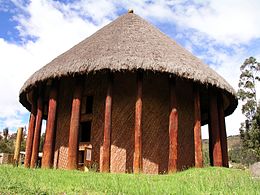Sué
| Sué | |
|---|---|
Sun | |
| Member ofMuisca religion | |
 Sué setting behindBacatá | |
| Other names | Xué,Sua,Zuhe,Suhé |
| Affiliation | Chiminigagua(light) Cuchavira(rainbow) Chibchacum(rain) |
| Major cult center | Sun Temple,Sugamuxi |
| Day | Summer solstice |
| Region | Altiplano Cundiboyacense |
| Ethnic group | Muisca |
| Consort | Chía(Moon) |
| Equivalents | |
| Etruscan equivalent | Usil |
| Greek equivalent | Helios |
| Hindu equivalent | Surya |
| Norse equivalent | Sól |
| Roman equivalent | Sol |
| Slavic equivalent | Dazhbog |
Sué,Xué,Sua,ZuheorSuhé[1]was thegodof theSunin thereligion of the Muisca.He was married toMoongoddessChía.[2][3]TheMuiscaand theirconfederationwere one of the four advanced civilizations of theAmericasand developed their own religion on theAltiplano Cundiboyacensein theAndes.Both the Sun and rain, impersonated byChibchacum,were very important for theiragriculture.
Description
[edit]
Archeology MuseumSogamoso
After the creation of light and the world byChiminigaguahe created Chía and Sué to represent the Moon and the Sun respectively.SpanishconquistadorGonzalo Jiménez de Quesadawrote about the Muisca: "they have the Sun and the Moon as breeders of all the things and believe they are together as husband and wife having created the councils".[2]
While Chía was related to thezipasof the southernMuisca Confederation,Sué was governing thezaquesof the northern Muisca.[4]Also thecaciqueofRamiriquíwas related to Sué.[5]
Sué was worshipped in theTemple of the SuninSugamuxi,currently known as Sogamoso, City of the Sun. Other temples attributed to Sué were inBacatáandGuatavita.[6]The original Sun Temple in Sogamoso has been destroyed by torch fires of the Spanish conquerors.[7]
On thedateof thesummer solstice,the Muisca nobles went in a procession to the temples where they made sacrifices to ask for blessings of the yearly harvests. The day was celebrated with grand fesitivies by the people who painted their bodies and got drunk withchicha.They also adored their own shadows as they believed that Sué gave them their own personal god that they carried with them all day.[4]
See also
[edit]References
[edit]- ^Ocampo López, 2007, Ch.V, p.218
- ^abOcampo López, 2013, Ch.4, p.33
- ^Ocampo López, 2007, Ch.V, p.220
- ^ab(in Spanish)Description of Sua– Pueblos Originarios – accessed 28-04-2016
- ^(in Spanish)Historias magicas de Chía y Sué– accessed 28-04-2016
- ^(in Spanish)Chía and Zuhe– Banco de la República – accessed 28-04-2016
- ^Ocampo López, 2013, Ch.1, p.18
Bibliography
[edit]- Ocampo López,Javier (2013),Mitos y leyendas indígenas de Colombia – Indigenous myths and legends of Colombia(in Spanish), Bogotá, Colombia: Plaza & Janes Editores Colombia S.A.,ISBN978-958-14-1416-1
- Ocampo López,Javier (2007),Grandes culturas indígenas de América - Great indigenous cultures of the Americas(in Spanish), Bogotá, Colombia: Plaza & Janes Editores Colombia S.A., pp. 1–238,ISBN978-958-14-0368-4

